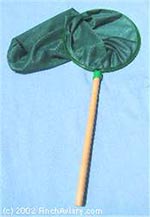|
CARE
TOPICS
|
||
|
C |
Diet
|
|
|
TIPS FOR CATCHING BIRDS (Summary) 1. Try catching the desired bird in the dark with the aid of a penlight. 2. Remove unnecessary perches. 3. Spray the desired bird with water. 4. Attempt to get the bird to land in a place where it will be easy to grab him/her. Flat surfaces, aviary mesh, corners, and the floor are ideal. 5. Enlist the help of another so that there is someone waiting at both ends of the aviary. 6. Partition the aviary with a shade or a sheet. 7. Before attempting to catch a bird, make sure the house is bird safe in case of an escape. 8. Don't spend more than 5 minutes at a time trying to catch a bird if possible. |
|
Catching Birds in an Aviary Catching a bird in an aviary is much more difficult than catching a bird in a cage. It has taken me a couple of years to acquire this skill. Fortunately, Tom is a natural. Tom has very quick hands, and if I flush the bird to his end of the aviary, he usually can nab it within a few attempts. Catching a bird in a cage is fairly simple, assuming the cage isn't too large. Usually, it just means chasing the bird into a corner, where you can gently get a hand on it (removing obstacles like extra perches first helps). But catching a bird in an aviary is a daunting task. First of all, I do not try to catch a bird without a good reason, as this is a very stressful activity for all of the birds. But when it must be done (nail clipping, separating feuding birds, hospitalizing a sick bird), it must be done. A general guideline is to work at catching the bird for no more than 5 minutes at a time so that you don't unduly stress out your birds. Some people like to try to catch their birds in the dark, when they are reluctant to fly, with the assistance of a pen light to locate the desired bird. Supposedly, you can just reach out and nab the targeted bird. I've never tried this approach because I am too afraid of inducing chaos in a totally dark aviary, causing birds to fly into walls and obstacles and potentially injure themselves (I have in the past accidentally startled the birds at night when it was dark and it incurred a panic in the aviary that I don't ever want to repeat). Another technique I've heard mentioned but have never tried is to spray the desired bird with water from a spray bottle. When they are wet, it is more difficult for them to fly and they can be caught more easily. I would not try this with a sick finch, however (but sick finches tend to be pretty easy to catch anyway). Catching birds in an aviary is much easier if there are two people. This is because an aviary tends to be a large place and if you are on one end, the birds are sure to be on the other. But if there is one person at each end, there is nowhere left for the birds to go. While they may land somewhere in between, their natural instinct when startled will be to fly all the way to the other end. If the desired bird is on my end, I attempt to grab him. If he flies to the other end, Tom is there waiting for him. Try to enlist the help of another, even if that other person does nothing other than usher the bird back to your end. Removing some of the perches before attempting to catch a bird will make your job easier. In particular, moving perches in the middle of the aviary, so that the birds must land on either end is helpful. Removing perches that will be in your way when trying to catch a bird is also helpful. I like to keep the sundecks in the aviary, because they are easy spots to catch birds on - when a bird lands on a sundeck, I quickly but gently drop my hand on top of it and pick it up. The floor is also an easy place to grab birds, especially if you can usher them into a corner, where they are more easily trapped. One of the biggest distractions when catching a bird are the other birds in the aviary. Assuming we are trying to catch a specific bird (as opposed to catching all of the birds), we usually try to isolate the desired bird as much as possible. We do this by pulling down one of the shades that divides the aviary while at least half of the birds are on the other side of the aviary. This accomplishes two things: 1. it prevents other birds from getting in our way and reduces stress for some of the birds; and 2. it shortens the length of the aviary giving the desired bird less space to escape into. Another tactic we have used in the past (before Tom became so experienced) is the divide and conquer method. An old bed sheet serves as the divider. Tom stands at one end of the aviary with the sheet. I usher the birds toward him. When the desired bird is about there, I alert him and he raises the sheet to prevent it from flying back to the other side. If possible, he lets the other birds escape to the other side, so that only the desired bird is trapped on the other side of the sheet. Then he gradually moves the sheet in toward the wall, so that the bird is confined to a small space. I then takeover holding up the sheet while he grabs the bird in question. Sometimes, in the chaos, a bird escapes from the aviary into the house. If it is the desired bird, this is a good thing, as it is relatively easy to catch a bird in the house using a bird net. We've found it too difficult to use a bird net in the aviary because the perches obstruct your ability to maneuver it. (Tom doesn't even use it in the house). Most of the time, escaped birds only want to get back into the aviary and they just fly along the aviary walls, trying to find a way in. Opening the door for them may be all that is necessary. Sometimes, they fly off quite startled. Usually, though, they land nearby and sit still trying to make sense out of their situation. To avoid injuries to birds loose in the house, never try to catch birds while there are unscreened windows or doors open. Shut doors in adjoining rooms to keep them as confined as possible. Make sure there is no water in kitchen sinks and close bathroom doors especially. Turn off ceiling fans. Keep other pets, such as cats and dogs, out of the vicinity. |
HOME
| CONSTRUCTION
| CARE
| BIRDS | ACCESSORIES
| BACKGROUND
AVICAM | GALLERY
| GUESTBOOK | LINKS
| SEARCH
SITE MAP | DISCLAIMER
| CONTACT US
(c)2004 FinchAviary.com



